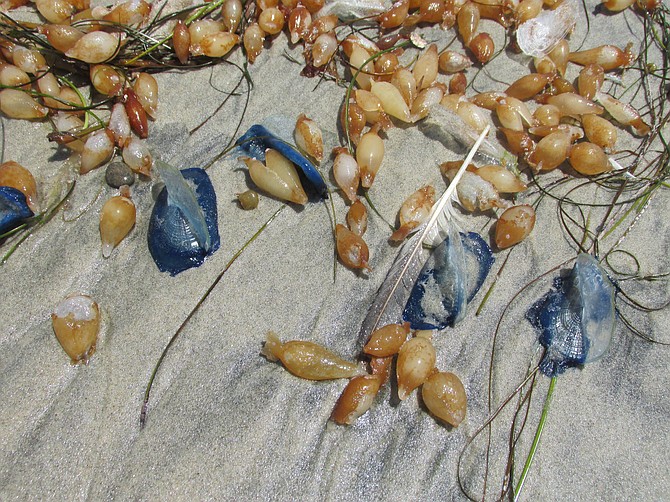 Facebook
Facebook
 X
X
 Instagram
Instagram
 TikTok
TikTok
 Youtube
Youtube

What were the little, deep-blue slimy things that washed up on Cardiff by the Sea’s beaches last week? There were several hundred of them deposited on the sand above the low-tide line in front of Restaurant Row on May 22.
According to several walkers on the beach, they can be a common occurrence just after there have been high waves accompanied by heavy winds.
A lifeguard at Seaside Beach identified the creatures as Velella velellas, also known as wind sailors. Unable to move on their own, their clear, hard, sail-like tops catch the wind and push them around the ocean. Unfortunately they get pushed onshore in heavy winds, and usually become stranded. Very few survive as they lay dying, waiting for high tide to return.
Many think they are jellyfish because of their small tentacles underneath. While they catch their prey — mostly plankton — with their tentacles and the use of a toxin, the toxin generally does not affect humans. But “I wouldn’t go putting them on my eyes and face,” cautioned one beach walker.
Because they have no means of propulsion, there have been mass strandings on the west coast beaches of North America. “We don’t usually see them this far south,” said a lifeguard.
When the blue membrane dries up, the remains look like pieces of clear cellophane, as if someone opened a CD package and left it on the beach. Do-gooders thinking they are picking up trash find that the remains quickly crumble.


What were the little, deep-blue slimy things that washed up on Cardiff by the Sea’s beaches last week? There were several hundred of them deposited on the sand above the low-tide line in front of Restaurant Row on May 22.
According to several walkers on the beach, they can be a common occurrence just after there have been high waves accompanied by heavy winds.
A lifeguard at Seaside Beach identified the creatures as Velella velellas, also known as wind sailors. Unable to move on their own, their clear, hard, sail-like tops catch the wind and push them around the ocean. Unfortunately they get pushed onshore in heavy winds, and usually become stranded. Very few survive as they lay dying, waiting for high tide to return.
Many think they are jellyfish because of their small tentacles underneath. While they catch their prey — mostly plankton — with their tentacles and the use of a toxin, the toxin generally does not affect humans. But “I wouldn’t go putting them on my eyes and face,” cautioned one beach walker.
Because they have no means of propulsion, there have been mass strandings on the west coast beaches of North America. “We don’t usually see them this far south,” said a lifeguard.
When the blue membrane dries up, the remains look like pieces of clear cellophane, as if someone opened a CD package and left it on the beach. Do-gooders thinking they are picking up trash find that the remains quickly crumble.
Comments